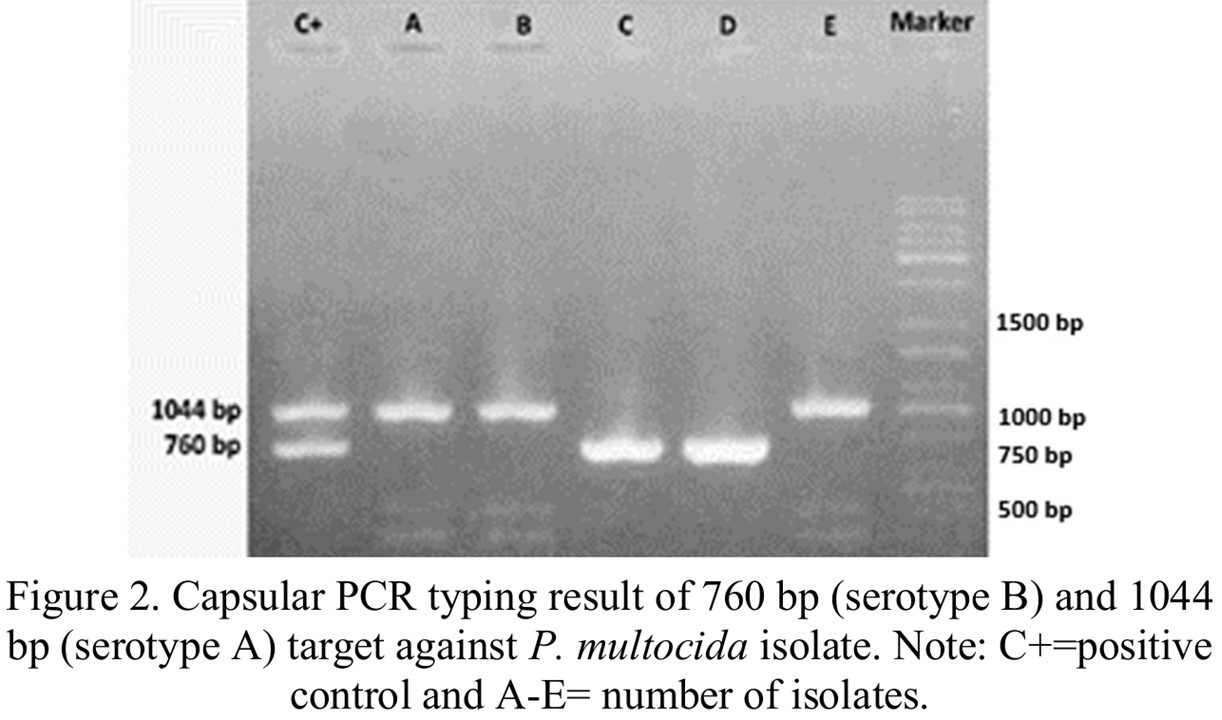Antibiotics resistance patters of Pasteurella multocida isolation from cattle
Abstract
This study aimed to evaluate the efficacy of multiple antibiotics, including oxytetracycline, enrofloxacin, gentamicin, ampicillin, and erythromycin, against Pasteurella multocida isolates from cattle. Antibiotic susceptibility was assessed using the disk diffusion method. The results revealed consistent sensitivity of P. multocida to enrofloxacin and gentamicin, whereas three of the five isolates remained susceptible to oxytetracycline. In contrast, all isolates exhibited resistance to erythromycin and ampicillin. Notably, Type A strains displayed higher resistance to oxytetracycline than Type B strains, potentially due to differential selective pressure. These findings underscore enrofloxacin and gentamicin as the most effective therapeutic options for hemorrhagic septicemia in cattle, given their robust antibacterial activity against P. multocida.
Downloads
References
Barrow GI, Feltham RKA. 2003. Cowan and Steel's Manual for Identification of Medical Bacteria. 3rd ed. Cambridge (UK): Cambridge University Press.
Brown JT, Davis AL, Patel S. 2019. Spread of antibiotic resistance genes in gram-negative bacteria. Veterinary Microbiology. 50(3):223-230.
Chander Y, Brust D, Antano A, DeDonder K, Falk R, Lechtenberg K, Lubbers B, Apley M, White B. 2017. Antimicrobial resistance profiles of Pasteurella multocida isolated from bovine respiratory cases. Veterinary Microbiology. 205:44-49.
Clark DR, Evans TW, Martinez RF, Nguyen LH. 2021. In vitro activity of gentamicin against Pasteurella multocida. International Journal of Antimicrobial Agents. 57(2):105-110.
[CLSI] Clinical and Laboratory Standards Institute. 2017. 45: Methods for Antimicrobial Dilution and Disk Susceptibility Testing of Infrequently Isolated or Fastidious Bacteria (3rd ed.). Clinical and La-boratory Standards Institute.
Davis AL, Moore JT, Richardson HB, Patel SK. 2019. Antimicrobial activity of enrofloxacin against Pasteurella multocida. Veterinary Microbiology. 50(4):145-150.
Diarra MS, Malouin F. 2014. Antimicrobial resistance mechanisms in Pasteurella multocida. Journal of Veterinary Medicine. 58(4):567-575.
Fulton RW, Step DL, Confer AW. 2021. Bovine Respiratory Disease (BRD) complex: recent developments and research. Journal of Animal Science. 99(3):153-167.
Griffin D, Smith W, Smith C. 2020. Management practices to reduce stress and improve health in livestock. Veterinary clinics of north america: Food Animal Practice. 36(1):27-45.
Hansen LM, Johnson SA, Smith PT, O'Connor RM, White EL. 2020. Genomic characterization of Pasteurella multocida and its antibiotic resistance mechanisms. Journal of Veterinary Science. 21(3):421-429.
Johnson MA, Brown JK, Lee SW. 2020. Plasmid-mediated resistance in Gram-negative bacteria: A review. Clinical Microbiology Reviews. 33(1): e00057-19.
[OIE] World Organisation for Animal Health Haemorrhagic Septicaemia. OIE Terrestrial Manual 2018, pp. 1125-1137.
Verma R, Sharma M, Gupta P. 2020. Recent advances in understand-ing Pasteurella multocida serotypes and their epidemiology. Frontiers in Veterinary Science. 7: 485.
Wilson M, Ho M. 2013. Pasteurellosis and its impact on livestock health. Journal of Veterinary Research. 40(2):123-136.

Copyright (c) 2025 CC-BY-SA

This work is licensed under a Creative Commons Attribution-ShareAlike 4.0 International License.
Authors who publish with this journal agree to the following terms:
1. Authors retain copyright and grant the journal right of first publication with the work simultaneously licensed under a Creative Commons Attribution License that allows others to share the work with an acknowledgement of the work's authorship and initial publication in this journal.
2. Authors are able to enter into separate, additional contractual arrangements for the non-exclusive distribution of the journal's published version of the work (e.g., post it to an institutional repository or publish it in a book), with an acknowledgement of its initial publication in this journal.
3. Authors are permitted and encouraged to post their work online (e.g., in institutional repositories or on their website) prior to and during the submission process, as it can lead to productive exchanges, as well as earlier and greater citation of published work (See The Effect of Open Access).

.jpg)















